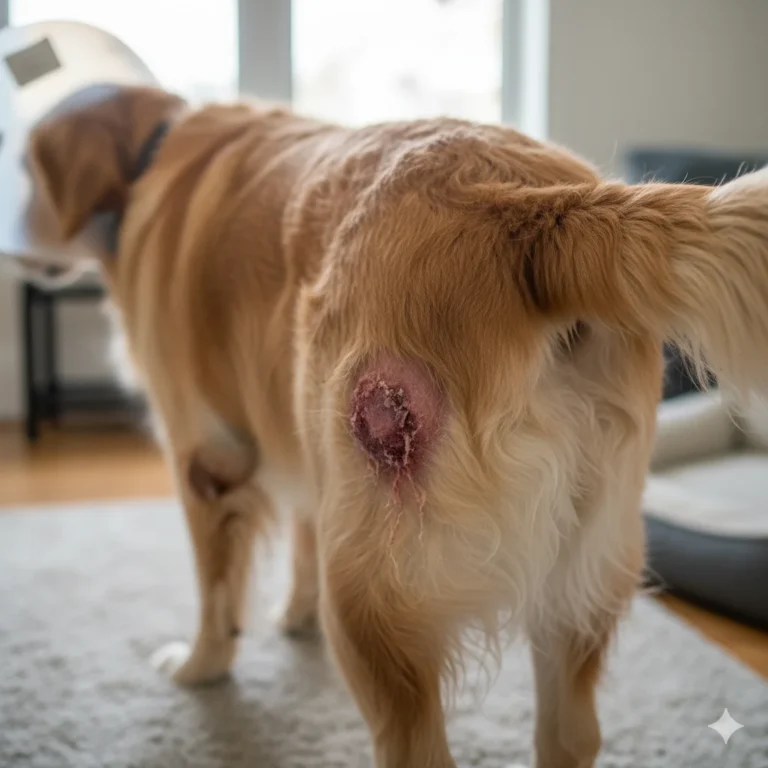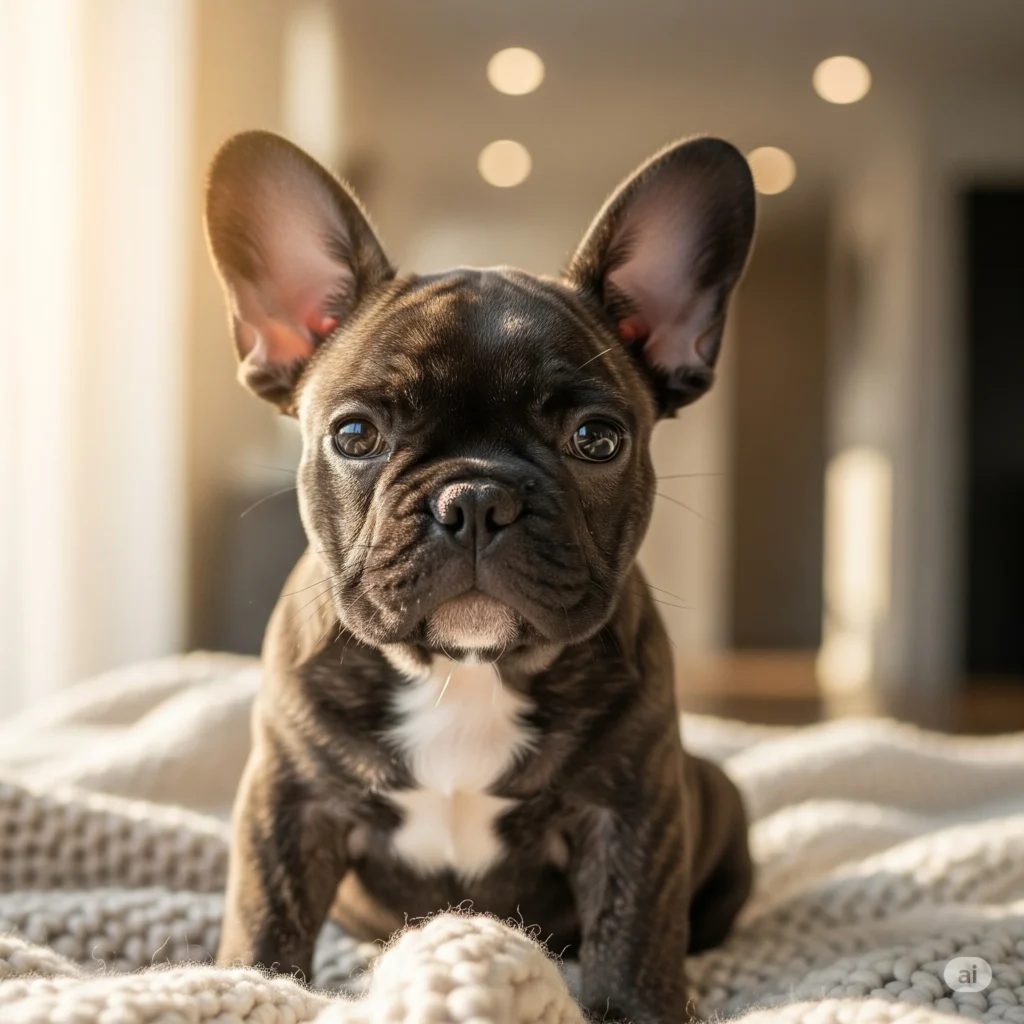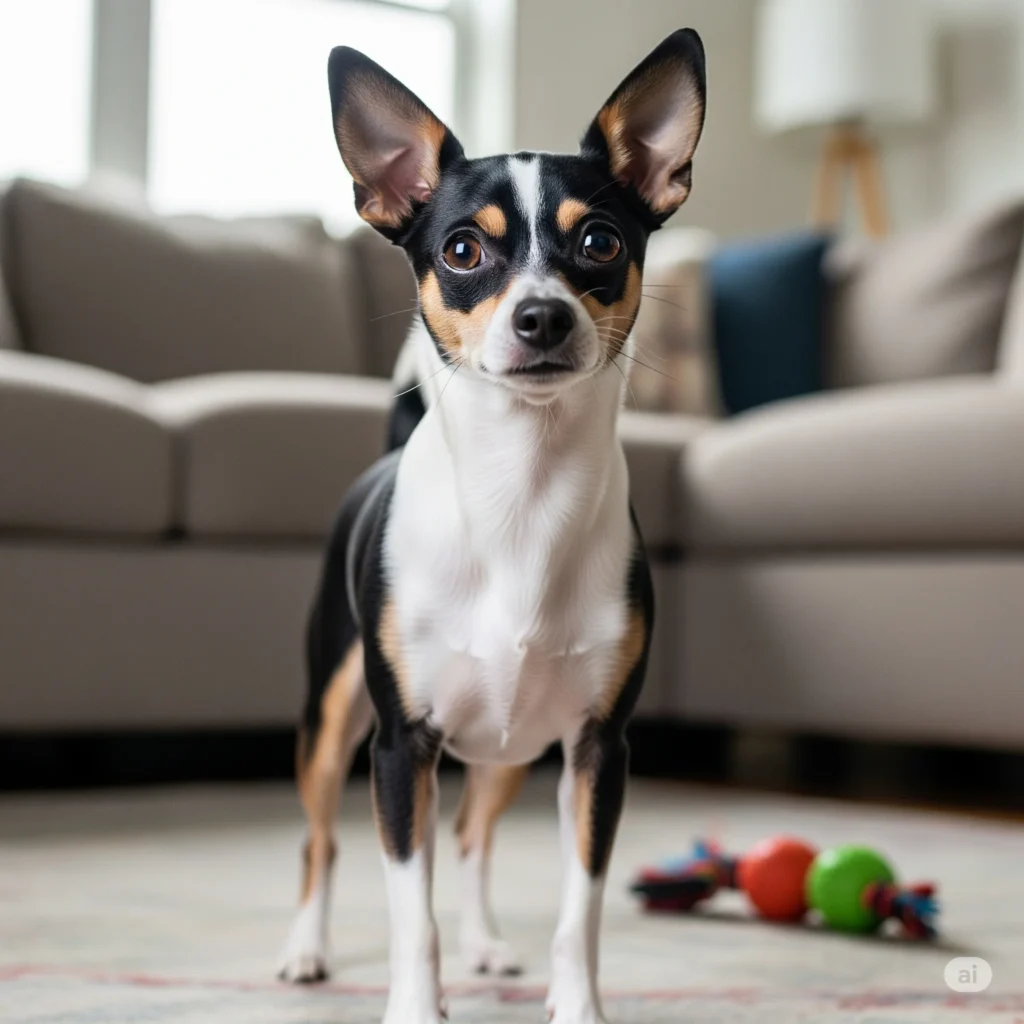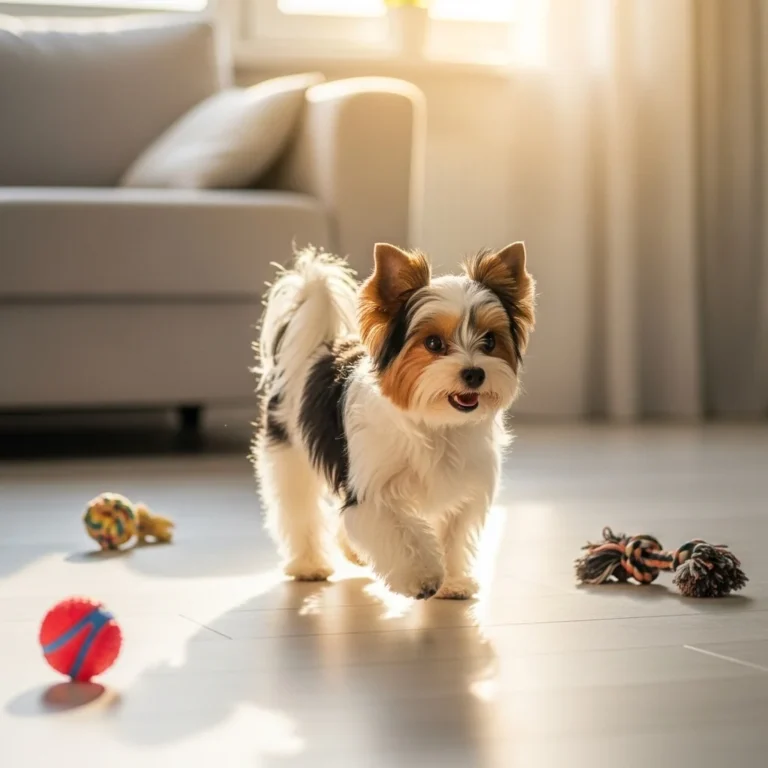
hot spot on dog
Oh, the dreaded “hot spot“! If you’re a dog parent, chances are you’ve either encountered one of these nasty skin irritations on your furry friend, or you’ve at least heard whispers of them. They’re painful, they’re annoying, and they can seemingly pop up out of nowhere. But don’t worry, you’re not alone, and understanding them is the first big step towards keeping your canine companion comfortable and happy.
Let’s dive into the world of hot spots, or as veterinarians call them, acute moist dermatitis. We’ll explore what they are, why they happen, how to spot them, and most importantly, how to get rid of them and stop them from coming back. Think of this as your friendly guide to navigating this common doggie dilemma.
Notice: You will find the sources at the end of the article.
Understanding Hot Spots
What exactly is a hot spot on a dog?
Imagine a small, itchy patch of skin that your dog just can’t leave alone. They lick it, they chew it, they scratch it, and before you know it, that small itch turns into a red, angry, oozing sore. That, my friend, is a hot spot. It’s a rapidly developing skin infection, usually bacterial, that occurs when your dog’s natural skin barrier is compromised, often by excessive licking or scratching.
Dr. Sarah Nold, a staff veterinarian at Trupanion, often explains hot spots simply as “a localized area of skin inflammation and infection that develops quickly.” It’s like a vicious cycle: something irritates the skin, the dog licks it, the licking makes it worse, and then bacteria, which are always present on the skin, seize the opportunity to multiply in the moist, warm environment.
related: Scurf on Dogs: Causes, Symptoms, and Easy Fixes
What do hot spots look like?
When you first notice a hot spot, it might just look like a small matted patch of fur. But if you gently part the hair (and believe me, your dog might not be thrilled about this, as it can be quite tender), you’ll reveal an angry, red, often oozing lesion. The skin will be inflamed, swollen, and can sometimes have pus or a crusty appearance. The fur around the area might be sticky and matted from the discharge.
Dr. Susan Wynn, a board-certified veterinary nutritionist, describes them as “often circular, hairless, red, and raw-looking lesions that can be quite painful.” They grow incredibly fast, sometimes doubling in size within a single day if left unchecked.
Are hot spots contagious to other pets or humans?
This is a common and understandable concern, but thankfully, the answer is generally no. Hot spots are not typically contagious to other pets or humans. They are a localized skin infection stemming from an imbalance in your dog’s own skin flora, often triggered by an underlying issue. So, you don’t need to worry about catching one from your dog or your other pets getting it just by being around them.
However, if the underlying cause is something contagious, like fleas, then the fleas themselves are contagious. In such cases, addressing the parasite issue for all pets in the household is crucial.
What is the difference between a hot spot and a regular skin irritation?
This is a great question, as many skin issues can look similar at first glance. The key difference with a hot spot is its rapid development and the intense, self-inflicted trauma that accompanies it. A regular skin irritation might be a mild rash, a dry patch, or a little itch from an insect bite. These usually don’t escalate into raw, oozing sores overnight.
A hot spot, on the other hand, is defined by that quick onset and the dog’s relentless focus on the area. That continuous licking and chewing create a warm, moist environment ripe for bacterial overgrowth, leading to the characteristic “moist” or “weeping” appearance. Regular skin irritations might be uncomfortable, but they typically don’t progress to such an acute, painful, and often oozing state without the dog’s persistent involvement.
Causes and Risk Factors
Understanding why hot spots happen is crucial for preventing them. It’s rarely just one thing; often, it’s a perfect storm of factors.
What causes hot spots to develop on dogs?
The immediate cause of a hot spot is always self-trauma – your dog licking, chewing, or scratching an area of their skin excessively. But why do they do that? That’s where the detective work begins!
Common culprits include:
- Allergies: This is a huge one. Environmental allergies (pollen, dust mites, mold) and food allergies can cause intense itchiness, leading your dog to relentlessly scratch or lick certain areas.
- Parasites: Fleas, mites (like sarcoptic or demodectic mange), and even ticks can cause localized irritation that drives a dog crazy with itching. A single flea bite on a sensitive dog can be enough to trigger a hot spot.
- Ear Infections: If your dog has an ear infection, they might scratch at their ears or the side of their face, which can lead to hot spots on the cheek or neck.
- Grooming Issues: Matted fur can trap moisture and irritate the skin underneath, making it a prime breeding ground for bacteria if a dog starts licking.
- Boredom or Stress: Sometimes, dogs can resort to compulsive licking or chewing when they are bored, anxious, or stressed, much like humans might bite their nails.
- Pain: Licking a painful joint or injury can also lead to a hot spot in that area.
- Moisture Trapping: Swimming or bathing without thorough drying can leave skin moist, especially in dense coats, creating an ideal environment for bacteria.
“Most hot spots start with an underlying itch,” says Dr. Judy Morgan, a holistic veterinarian. “Finding that original source of irritation is key to long-term prevention.”
Are certain dog breeds more prone to hot spots?
Yes, absolutely! While any dog can get a hot spot, some breeds seem to have a predisposition, often due to their coat type or common breed-specific allergies. Breeds with dense undercoats or long, thick fur are more susceptible because moisture and heat can get trapped against their skin more easily.
Some of the breeds often seen with hot spots include:
- Golden Retrievers
- Labrador Retrievers
- German Shepherds
- Rottweilers
- St. Bernards
- Newfoundlands
- Bernese Mountain Dogs
- Huskies
- Akitas
These breeds often love water, which, coupled with their thick coats, can become a recipe for trapped moisture and skin irritation if not dried properly.
Does the environment (e.g., humidity, allergies) play a role in hot spot formation?
Oh, a huge role! Think about it: hot, humid weather means more sweating, more moisture, and a perfect breeding ground for bacteria. If your dog gets wet from swimming, rain, or a bath and isn’t thoroughly dried, that trapped moisture can quickly lead to skin irritation and a hot spot.
Environmental allergies are also massive contributors. Just like some people get hay fever, dogs can be allergic to pollen, grass, dust mites, and mold. These allergies often manifest as itchy skin, especially on the paws, belly, ears, and armpits. A dog constantly licking their paws due to allergies is a prime candidate for a hot spot.
“Humidity and allergies are significant factors,” notes Dr. Audrey Cook, a small animal internal medicine specialist. “Many dogs experience seasonal flare-ups of hot spots corresponding with peak allergy seasons.”
Can fleas or other parasites lead to hot spots?
A resounding YES! Fleas are one of the most common triggers for hot spots. Even if your dog isn’t crawling with fleas, just a few bites can be enough to drive a flea-allergic dog absolutely crazy. They’ll chew and scratch intensely at the bite sites, quickly turning a small irritation into a full-blown hot spot.
Other parasites, like various mites that cause mange (sarcoptic or demodectic), can also lead to intense itching and subsequent hot spot development. It’s why your vet will almost always check for parasites when your dog presents with skin issues. Regular, year-round flea and tick prevention is one of the easiest and most effective ways to prevent many hot spots.
Is stress a factor in hot spot development?
Believe it or not, yes, stress can absolutely play a role. Just like humans might develop skin issues or other physical symptoms when stressed, some dogs react to anxiety or boredom by compulsively licking or chewing. This is often referred to as an “obsessive-compulsive disorder” in dogs. If a dog is left alone for long periods, is experiencing separation anxiety, or is undergoing significant changes in their environment, they might start self-soothing by excessively licking a particular spot. This continuous licking can easily break down the skin barrier and lead to a hot spot, even without an initial allergic trigger.
Can matted fur contribute to hot spots?
Absolutely. Matted fur is a hot spot waiting to happen. Mats pull on the skin, causing irritation and pain. More importantly, they trap moisture, dirt, and debris against the skin, creating a warm, damp environment that bacteria love. If your dog has a mat and starts licking or scratching at it because it’s uncomfortable, the skin underneath can quickly become inflamed and infected, turning into a hot spot. Regular grooming, especially for long-haired breeds, is vital to prevent matting and, in turn, hot spots.
Symptoms and Diagnosis
Catching a hot spot early can make a huge difference in treatment and recovery time.
How can I tell if my dog has a hot spot?
The most obvious sign will be your dog’s behavior. They’ll be obsessively licking, chewing, or scratching a specific area of their body, seemingly unable to leave it alone. If you notice this behavior, gently investigate the spot (if your dog allows).
You might see:
- A red, inflamed patch of skin.
- Matted, sticky fur over the area.
- Oozing or moist discharge.
- Pus or crusts.
- Hair loss in the affected area.
- The area will likely be painful to the touch.
Don’t be surprised if the spot is much larger than you initially thought once you part the fur. They can spread very rapidly.
What are the early signs of a hot spot?
Early detection is key! Before it becomes a raw, oozing mess, you might notice:
- Subtle, persistent licking or chewing at a particular spot that seems out of the ordinary.
- A small patch of slightly reddened skin that might just look a little irritated.
- A small area of matted fur that feels damp or sticky.
- Your dog might flinch or whine if you touch the area, indicating tenderness.
At this stage, if you can intervene – perhaps with a protective collar or a mild antiseptic wipe – you might be able to stop it from escalating.
Where do hot spots most commonly appear on a dog’s body?
Hot spots can appear anywhere, but there are definitely some hotspots (pun intended!) for hot spots:
- Hips and thighs: Often linked to allergies or fleas, especially near the tail base.
- Base of the tail: Very common with flea allergies.
- Sides of the face and neck: Frequently associated with ear infections or allergies affecting the head.
- Paws: Often due to environmental allergies or interdigital cysts.
- Flanks: Can be related to generalized skin irritation.
- Underneath collars: If collars are too tight or trap moisture.
Essentially, any area a dog can comfortably and persistently lick, chew, or scratch is fair game.
When should I take my dog to the vet for a hot spot?
While early, very minor irritations might be managed at home, it’s generally best to consult your veterinarian as soon as you suspect a hot spot. Here’s why:
- They spread quickly: What starts as a small patch can become a large, painful lesion in a day.
- Underlying causes: Your vet can help identify the root cause (allergies, fleas, etc.) to prevent recurrence.
- Pain management: Hot spots are painful. Your vet can prescribe appropriate pain relief.
- Proper cleaning and medication: They can properly clean the wound and prescribe antibiotics (topical or oral) if necessary to clear the infection.
- Prevention of secondary issues: Untreated hot spots can lead to deeper skin infections or scarring.
“Don’t hesitate to call your vet,” advises Dr. Marty Becker, “because hot spots are notoriously fast-growing and painful. The sooner you treat them, the better for your dog.”
Treatment and Management
Once a hot spot has developed, quick and effective treatment is essential to relieve your dog’s discomfort and promote healing.
How are hot spots typically treated by a veterinarian?
When you bring your dog to the vet with a hot spot, they’ll usually follow a pretty standard protocol:
- Clipping the Area: This is often the first and most crucial step. The fur around and over the hot spot is carefully clipped away. This allows the area to dry out, makes it easier to clean, and prevents further matting and bacterial growth.
- Cleaning the Wound: The vet will gently clean the hot spot with an antiseptic solution to remove pus, crusts, and bacteria. This can be a bit uncomfortable for your dog, so sometimes mild sedation or pain relief is given.
- Medication:
- Topical Treatments: These often include antibiotic creams or sprays, or corticosteroid sprays to reduce inflammation and itching.
- Oral Medications: For more severe or widespread hot spots, oral antibiotics might be prescribed to fight the bacterial infection from within. Oral corticosteroids (like prednisone) may also be used for a short course to quickly reduce inflammation and itchiness.
- Pain Relief: Your vet might prescribe a non-steroidal anti-inflammatory drug (NSAID) to help manage the pain and swelling.
- E-collar (Cone of Shame): This is almost always necessary to prevent your dog from continuing to lick, chew, or scratch the area, which would undo all the treatment. It’s not fun, but it’s vital for healing.
- Addressing the Underlying Cause: This is where your vet will discuss investigating what triggered the hot spot in the first place – whether it’s fleas, allergies, or another issue.
What can I do at home to help manage my dog’s hot spot?
After a vet visit, your main job at home is to diligently follow their instructions. Here’s what that usually entails:
- Keep the area clean and dry: Gently clean the hot spot as instructed by your vet, often with a mild antiseptic like chlorhexidine solution. Pat it dry thoroughly.
- Apply topical medications: Use any prescribed creams or sprays exactly as directed.
- Ensure the E-collar stays on: This is non-negotiable! No sneaking it off, even for a second, if your dog is still intent on licking.
- Administer oral medications: Give all antibiotics, steroids, or pain relievers as prescribed, and complete the full course of antibiotics even if the hot spot looks better.
- Monitor the area: Keep an eye on the hot spot for signs of improvement or worsening. If it’s getting larger, more painful, or not healing, contact your vet.
Are there any effective home remedies for hot spots?
This is a tricky one. While there are many anecdotal “home remedies” floating around, it’s generally best to be very cautious and always consult your vet before trying anything on an active hot spot. Many things can irritate already compromised skin or delay proper healing.
Things your vet might approve as a temporary measure after proper clipping and cleaning, or for a very minor, early irritation, could include:
- Cool compresses: To soothe inflammation (but ensure the area is dried completely afterward).
- Diluted apple cider vinegar: Some people use a very diluted solution as an astringent, but this can sting and irritate raw skin.
- Witch hazel: Can be soothing and anti-inflammatory, but again, ensure it doesn’t cause further irritation.
However, the most effective “home remedy” is proactive prevention and swift professional treatment. Trying to treat a full-blown, oozing hot spot with unproven home remedies can lead to worsening infection, increased pain, and a much longer recovery.
Do I need to shave the fur around a hot spot?
Yes, almost always! This is a crucial step that your veterinarian will perform or instruct you to do if it’s a very minor case. Shaving the fur around and often slightly beyond the hot spot serves several vital purposes:
- Allows the skin to breathe and dry: Trapped fur holds moisture, creating a perfect environment for bacteria.
- Facilitates cleaning: You can properly clean the raw skin without fur getting in the way.
- Enables topical medication application: Medications can reach the skin directly.
- Helps assess the full extent: Hot spots often look smaller than they are; removing the fur reveals the true size of the lesion.
Do not attempt to shave a large or painful hot spot yourself if you’re not comfortable or if your dog is in pain. A vet can do it safely, often with specialized clippers and sometimes with mild sedation.
What kind of medications (topical or oral) are used for hot spots?
Medications for hot spots aim to fight infection, reduce inflammation, and stop the itch-scratch cycle.
- Topical Antibiotics/Antiseptics: Sprays, creams, or ointments containing antibiotics (like neomycin or polymyxin B) or antiseptics (like chlorhexidine) are applied directly to the shaved and cleaned hot spot. They help kill the surface bacteria.
- Topical Corticosteroids: Sprays or creams with corticosteroids (like hydrocortisone or betamethasone) are used to quickly reduce inflammation and intense itching. These are often combined with antibiotics.
- Oral Antibiotics: If the infection is significant or deep, your vet will likely prescribe oral antibiotics (e.g., cephalexin, clindamycin, amoxicillin-clavulanate) for 10-21 days or longer. It’s crucial to finish the entire course.
- Oral Corticosteroids: For very itchy and inflamed hot spots, a short course of oral steroids (like prednisone) can provide rapid relief by calming the immune response and reducing itchiness.
- Pain Relievers: NSAIDs (e.g., carprofen, meloxicam) might be prescribed to manage the pain and swelling associated with the hot spot.
- Antihistamines: While generally less effective for acute hot spots, some vets might suggest antihistamines for underlying allergic itch.
How long does it take for a hot spot to heal?
The healing time for a hot spot can vary quite a bit depending on its size, severity, and how quickly treatment was started.
- Initial improvement: You should typically see significant improvement within 3-5 days of starting treatment, especially if the area is kept clean and dry, and the dog is prevented from licking. The redness and oozing should decrease.
- Full healing: A hot spot can take anywhere from 1 to 3 weeks to fully heal, with hair regrowth starting around the 2-3 week mark. Larger or deeper infections will take longer.
It’s vital to continue all prescribed medications for the full duration, even if the hot spot looks much better, to prevent a relapse of the bacterial infection.
What if my dog keeps licking or scratching the hot spot?
This is the biggest hurdle in hot spot treatment! If your dog continues to lick or scratch, the hot spot will simply not heal, and it will likely get worse. This is why the Elizabethan collar (E-collar or “cone of shame”) is absolutely essential.
- The E-collar is your best friend: It’s inconvenient, yes, but it’s the most effective way to break the lick-scratch cycle. Ensure it’s fitted correctly so your dog can’t bend around it to reach the spot.
- Bitter sprays: While some people try bitter-tasting sprays on the area, these are often not strong enough to deter a determined licker. Plus, if the hot spot is raw, it might cause further irritation.
- Bandages/dressings: These can sometimes be used for protection, but they must be applied correctly by a vet to avoid trapping moisture and worsening the problem. They also need to be changed frequently.
- Body suits/recovery shirts: For hot spots on the body, a recovery suit can sometimes provide a physical barrier without the bulk of a cone, but again, ensure it allows air circulation.
If your dog is still managing to get at the hot spot despite an E-collar, contact your vet immediately. They might need to adjust the collar, try a different type, or consider other deterrents.
Prevention
The best treatment is always prevention! Once you’ve dealt with a hot spot, you’ll want to do everything you can to keep them from coming back.
How can I prevent hot spots from recurring on my dog?
Preventing recurrence means addressing the root cause that initially triggered the hot spot. This is the most important long-term strategy.
- Strict Flea Control: Year-round, consistent flea and tick prevention is non-negotiable, even if you don’t see fleas. Many dogs are highly allergic to flea saliva.
- Allergy Management: If allergies are suspected, work with your vet to identify and manage them. This might involve:
- Dietary changes: For food allergies.
- Environmental modifications: Reducing dust mites, frequent bathing for pollen allergies.
- Medications: Antihistamines, Apoquel, Cytopoint, or allergy desensitization shots.
- Regular Grooming: Especially for long-haired or thick-coated breeds.
- Thorough Drying: After baths or swimming, ensure your dog is completely dry, especially in dense undercoats.
- Address Underlying Ear Infections: Treat ear infections promptly to prevent head scratching.
- Manage Boredom/Stress: Ensure your dog gets enough exercise, mental stimulation, and enrichment to prevent compulsive licking behaviors.
- Monitor Known Hot Spot Areas: Be vigilant about checking areas where your dog has had hot spots before.
“Prevention is multi-faceted,” advises veterinary dermatologist Dr. Rusty Muse. “It often involves a combination of parasite control, allergy management, and good skin hygiene.”
Does regular grooming help prevent hot spots?
Absolutely, 100%! Regular grooming is one of your most powerful tools against hot spots, especially for dogs with long, thick, or dense coats.
- Prevents Matting: Mats trap moisture, dirt, and bacteria, and pull on the skin, all of which can initiate an itch or irritation. Regular brushing prevents these painful tangles.
- Removes Dead Undercoat: Excessive undercoat can trap heat and moisture against the skin. Regular deshedding can help.
- Allows for Skin Inspection: Brushing gives you a chance to inspect your dog’s skin for any early signs of irritation, fleas, or other issues before they escalate.
- Improves Air Circulation: A well-groomed coat allows better air circulation to the skin, helping to keep it dry and healthy.
Consider professional grooming every 4-8 weeks for breeds prone to matting or hot spots, or learn proper techniques for at-home grooming.
Is diet important in preventing hot spots?
Yes, diet can play a significant role, particularly if your dog has food allergies or sensitivities.
- Food Allergies: If a food allergy is the underlying cause of itching, feeding a limited ingredient diet or a hydrolyzed protein diet (under veterinary guidance) can dramatically reduce skin inflammation and itchiness, thereby preventing hot spots.
- Skin Health: A high-quality diet rich in essential fatty acids (like Omega-3s) can promote healthy skin and a strong skin barrier, making your dog less susceptible to irritation.
- Probiotics: Some vets suggest probiotics to support overall gut health, which can indirectly impact skin health and the immune system.
“Nutrition is foundational to skin health,” says Dr. Karen Becker, a proactive and integrative veterinarian. “A species-appropriate diet can bolster the immune system and reduce inflammation, which is critical for preventing skin issues.”
Should I use specific shampoos or conditioners to prevent hot spots?
For dogs prone to hot spots, using therapeutic shampoos and conditioners can be very beneficial.
- Antimicrobial Shampoos: Shampoos containing chlorhexidine or benzoyl peroxide can help keep bacterial and yeast populations on the skin in check, especially for dogs with recurrent skin infections.
- Medicated Shampoos for Allergies: If allergies are the root cause, shampoos designed to soothe itchy skin, often containing oatmeal or ceramides, can provide relief.
- Moisturizing Conditioners: Maintaining skin hydration is important for barrier health.
- Hypoallergenic Shampoos: If your dog has sensitive skin, opt for gentle, fragrance-free, hypoallergenic options.
Always follow your vet’s recommendation for specific shampoo types and how often to use them. Over-bathing or using harsh products can strip natural oils and worsen skin issues.
How can I manage my dog’s allergies to prevent hot spots?
Managing allergies is often a long-term commitment, but it’s crucial for hot spot prevention. Here are key strategies:
- Veterinary Diagnosis: The first step is to accurately diagnose the type of allergy (environmental, food, or flea) through skin tests, elimination diets, or flea control trials.
- Environmental Allergy Management:
- Reduce exposure: If allergic to dust mites, frequent vacuuming, washing bedding, and air purifiers can help. For pollen, wipe paws and fur after outdoor excursions, and bathe regularly with a soothing shampoo.
- Medications: Your vet might prescribe antihistamines, corticosteroids (for flare-ups), Apoquel, or Cytopoint injections to control the itch.
- Immunotherapy (Allergy Shots): For severe environmental allergies, desensitization injections (allergy shots) can be very effective in the long run by retraining the immune system.
- Food Allergy Management:
- Elimination Diet: A strict 8-12 week elimination diet with a novel protein or hydrolyzed protein food is the gold standard for diagnosis and management.
- Strict Adherence: Once the offending allergen is identified, strictly avoid it in all treats and food.
- Flea Allergy Management: Consistent, year-round flea prevention for all pets in the household.
“Allergy management is often a marathon, not a sprint,” says Dr. Ashley Bourgeois, a board-certified veterinary dermatologist. “But with patience and the right plan, you can significantly improve your dog’s quality of life and reduce hot spot frequency.”
Are there any supplements that help prevent hot spots?
Supplements can be a helpful addition to a comprehensive prevention plan, especially for supporting skin barrier health.
- Omega-3 Fatty Acids: These are anti-inflammatory and can improve skin and coat health. Look for fish oil or algal oil supplements with high EPA and DHA content.
- Probiotics: Supporting a healthy gut microbiome can indirectly benefit skin health and the immune system.
- Antioxidants: Vitamins E and C can help reduce inflammation and support skin health.
- Zinc: Important for skin healing and immune function.
Always discuss supplements with your veterinarian before adding them to your dog’s routine, as they can interact with medications or not be appropriate for all dogs.
Long-Term Concerns
What happens if a hot spot is more than just a passing annoyance?
Can hot spots lead to more serious skin conditions?
Yes, they absolutely can. While a single, promptly treated hot spot usually heals without lasting issues, neglected or recurring hot spots can lead to:
- Deeper Skin Infections (Pyoderma): If the superficial bacterial infection isn’t treated, it can spread deeper into the skin layers, requiring more intensive and longer courses of antibiotics.
- Cellulitis: A widespread bacterial infection of the skin and subcutaneous tissue.
- Scarring: Chronic inflammation and repeated damage can lead to permanent scarring and changes in skin texture or hair growth in the affected area.
- Hair Follicle Damage: Repeated hot spots in the same area can damage hair follicles, leading to permanent hair loss.
- Yeast Infections: The moist, compromised skin is also an ideal breeding ground for yeast (Malassezia), leading to secondary yeast infections that can be very itchy and smelly.
What happens if a hot spot is left untreated?
Leaving a hot spot untreated is not only incredibly painful for your dog but also risky for their health.
- Rapid Growth: Untreated hot spots will continue to grow larger, becoming more painful and difficult to manage.
- Worsening Infection: The bacterial infection will deepen and spread, potentially leading to more serious skin conditions like deep pyoderma or cellulitis.
- Systemic Infection: In rare, severe cases, the infection can enter the bloodstream, leading to a systemic illness (sepsis), which is a life-threatening condition.
- Chronic Itch-Scratch Cycle: Without intervention, the dog will continue to lick and scratch, preventing any healing and perpetuating their discomfort.
- Scarring and Hair Loss: Permanent skin damage can occur.
Think of it this way: an untreated hot spot is like an open wound that’s constantly being irritated and reinfected. It will not simply get better on its own.
Will my dog always be prone to hot spots once they’ve had one?
Unfortunately, if your dog has had one hot spot, especially if the underlying cause isn’t fully identified and managed, they do have a higher likelihood of experiencing them again. It often indicates an underlying predisposition or sensitivity.
However, this doesn’t mean they’re doomed to a lifetime of hot spots! With a proactive approach, diligent care, and addressing those root causes (fleas, allergies, grooming issues, stress), you can significantly reduce the frequency and severity of future hot spots. Many dogs who once suffered from recurrent hot spots live hot spot-free lives with proper management.
It’s all about being a vigilant dog parent, knowing what to look for, and working closely with your veterinarian to keep your beloved companion comfortable and their skin healthy!
please leave comment
you may like it





sources
- https://www.trupanion.com/pet-care/dog-hot-spots
- https://veterinarypartner.vin.com/default.aspx?pid=19239&id=4951475
- https://health.clevelandclinic.org/what-are-hot-spots-on-dogs/
- https://www.akc.org/expert-advice/health/hot-spots-on-dogs/
- https://www.aaha.org/publications/newstat/articles/2022-09/hot-spots-in-dogs-symptoms-causes-and-treatment/
- https://www.merckvetmanual.com/dog-owners/skin-disorders-of-dogs/bacterial-skin-infections-pyoderma-in-dogs
- https://todaysveterinarypractice.com/dermatology/hot-spots-in-dogs-an-owners-guide-to-acutemoist-dermatitis/
- https://www.vet.cornell.edu/departments-centers-and-institutes/riney-canine-health-center/canine-health-information/hot-spots
- https://news.vt.edu/articles/2025/07/canine-dog-hot-spots-dermatology-veterinary-medicine.html
- https://veterinarypartner.vin.com/default.aspx?catId=102903&id=4952981&pid=19239
- https://vcahospitals.com/know-your-pet/hot-spots-in-dogs
- https://www.petmd.com/dog/general-health/hot-spots-dogs
- https://www.maplegrovepethospital.com/blog/hot-spots-on-dogs-causes-and-treatments/

